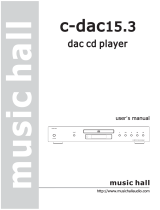
13 En
SHUFFLE key
Performs shuffle playback.
• This operation is ineffective for MP3 or WMA discs.
• The shuffle playback mode is cancelled when playback is
stopped or the disc is ejected.
8 (Search backward) key
(Search forward) key
Searches tracks backward/forward.
(Pause) key
Pauses playback. Press the or key to
resume playback.
(Play) key
Starts playback.
(Skip backward) key
Press the key once to skip back to the beginning of
the current track.
Press it twice to skip to the beginning of the
previous track.
(Skip forward) key
Press the key once to skip to the next track.
(Stop) key
Stops playback.
9 SOURCE key
Selects the audio source to be played back. Each time
you press this key, the audio source is switched as
shown below.
y
The audio source setting is retained even if you turn off this
unit.
0 PURE DIRECT key
Allows you to enjoy high audio quality.
y
• Press this key again to turn off the PURE DIRECT mode.
• This setting is retained even if you turn off this unit.
When PURE DIRECT is on:
• The audio signals are output only from the BALANCED
OUT jacks and the ANALOG OUT jacks.
• The front panel display will show only the minimum
indicators and messages.
A DISPLAY key
Switches the time display. Each time you press the
DISPLAY key during playback, the time display
changes as follows:
TRACK: Elapsed time of the current track
TRACK REMAIN:
Remaining time of the current track
TOTAL REMAIN: Total remaining time of the disc
B ENTER key
Confirms a track number entered when you are
programming tracks.
CLEAR key
Erases the last programmed track when this unit is in
the program editing mode. See “Program playback”
(page 14).
y
To erase all programmed tracks, press the CLEAR key while
programmed playback is stopped.
C LAYER key
Switches the playback layer of a hybrid Super Audio
CD between SA-CD and CD while playback is
stopped (page 27).
y
This setting is retained even if you turn off this unit.
When SA-CD layer is selected, audio signals are output only
from the BALANCED OUT and ANALOG OUT jacks.
D Yamaha amplifier operation keys
Operates the Yamaha amplifier.
Refer to the owner’s manual of your amplifier for
details.
Some Yamaha amplifiers cannot be controlled with the keys
of this remote control.
Notes
Notes
(coaxial digital input) (optical digital input)
Note
Note
See page 28 for more information on MP3/WMA
playback.
English




















